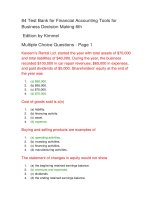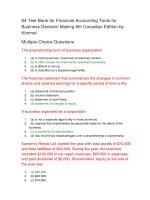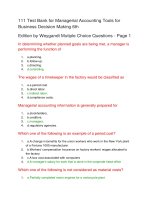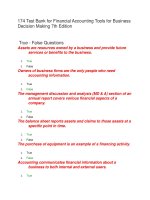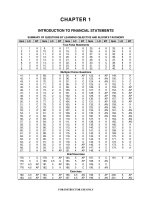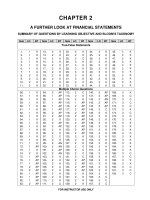TEST BANK ACCOUNTING TOOLS FOR BUSINESS DECISION MAKING 6TH EDITION KIMMEL app g
Bạn đang xem bản rút gọn của tài liệu. Xem và tải ngay bản đầy đủ của tài liệu tại đây (162.41 KB, 20 trang )
APPENDIX G
TIME VALUE OF MONEY
SUMMARY OF QUESTIONS BY OBJECTIVES AND BLOOM’S TAXONOMY
Item
LO
BT
Item
LO
BT
Item
LO
BT
Item
LO
BT
Item
LO
BT
2
3
C
K
9.
10.
3
4
K
K
29.
30.
31.
32.
33.
34.
2
2
2
2
2
2
AP
AP
AP
C
AP
AP
35.
36.
37.
38.
39.
40.
2
2
2
2
2
2
AP
AP
C
AP
AP
AP
59.
60.
61.
62.
63.
64.
2
2
2
2
2
2
AP
AP
AP
AP
AN
AP
65.
66.
2
2
AP
AP
3
K
True-False Statements
1.
2.
1
1
K
K
3.
4.
1
1
K
C
5.
6.
2
2
K
K
7.
8.
Multiple Choice Questions
11.
12.
13.
14.
15.
16.
1
1
1
1
1
1
K
C
AP
K
K
C
17.
18.
19.
20.
21.
22.
1
1
1
1
2
2
AP
K
AP
K
K
C
23.
24.
25.
26.
27.
28.
2
2
2
2
2
2
C
AP
AP
AP
AP
C
Exercises
41.
42.
43.
44.
45.
46.
1
1
1
1
1
1
AP
AP
AP
AP
AP
AP
47.
48.
49.
50.
51.
52.
1
1
1
1
1
2
AP
AP
AP
AP
AP
AP
53.
54.
55.
56.
57.
58.
2
2
2
2
2
2
AP
AP
AP
AP
AP
AP
Completion Statements
67.
1
K
68.
1
K
69.
2
K
70.
G-2
Test Bank for Accounting: Tools for Business Decision Making, Sixth Edition
SUMMARY OF LEARNING OBJECTIVES BY QUESTION TYPE
Item
Type
Item
Type
Item
1.
2.
3.
4.
TF
TF
TF
TF
11.
12.
13.
14.
MC
MC
MC
MC
15.
16.
17.
18.
5.
6.
7.
8.
9.
21.
TF
TF
TF
MC
MC
MC
22.
23.
24.
25.
26.
27.
MC
MC
MC
MC
MC
MC
28.
29.
30.
31.
32.
33.
10.
TF
70.
C
Note: TF = True-False
MC = Multiple Choice
Type
Item
Type
Item
Learning Objective 1
MC
19. MC
43.
MC
20. MC
44.
MC
41. Ex
45.
MC
42. Ex
46.
Learning Objective 2
MC
34. MC
40.
MC
35. MC
52.
MC
36. MC
53.
MC
37. MC
54.
MC
38. MC
55.
MC
39. MC
56.
Learning Objective 3
C = Completion
Ex = Exercise
The chapter also contains one set of five Matching questions.
Type
Item
Type
Item
Type
Ex
Ex
Ex
Ex
47.
48.
49.
50.
Ex
Ex
Ex
Ex
51.
67.
68.
Ex
C
C
MC
Ex
Ex
Ex
Ex
Ex
57.
58.
59.
60.
61.
62.
Ex
Ex
Ex
Ex
Ex
Ex
63.
64.
65.
66.
69.
Ex
Ex
Ex
Ex
C
Time Value of Money
G-3
CHAPTER LEARNING OBJECTIVES
1. Compute interest and future values. Simple interest is computed on the principal only, while
compound interest is computed on the principal and any interest earned that has not been
withdrawn.
To solve for future value of a single amount, prepare a time diagram of the problem. Identify
the principal amount, the number of compounding periods, and the interest rate. Using the
future value of 1 table, multiply the principal amount by the future value factor specified at the
intersection of the number of periods and the interest rate.
To solve for future value of an annuity, prepare a time diagram of the problem. Identify the
amount of the periodic payments (receipts), the number of payments, and the interest rate.
Using the future value of an annuity of 1 table, multiply the amount of the payments by the
future value factor specified at the intersection of the number of periods and the interest rate.
2. Compute present value. The following three variables are fundamental to solving present
value problems: (1) the future amount, (2) the number of periods, and (3) the interest rate (the
discount rate).
To solve for present value of a single amount, prepare a time diagram of the problem. Identify
the future amount, the number of discounting periods, and the discount (interest) rate. Using
the present value of a single amount table, multiply the future amount by the present value
factor specified at the intersection of the number of periods and the discount rate.
To solve for present value of an annuity, prepare a time diagram of the problem. Identify the
amount of future periodic receipts or payment (annuities), the number of discounting periods,
and the discount (interest) rate. Using the present value of an annuity of 1 table, multiply the
amount of the annuity by the present value factor specified at the intersection of the number of
periods and the interest rate.
To compute the present value of notes and bonds, determine the present value of the principal
amount: Multiply the principal amount (a single future amount) by the present value factor
(from the present value of 1 table) intersecting at the number of periods (number of interest
payments) and the discount rate. To determine the present value of the series of interest
payments: Multiply the amount of the interest payment by the present value factor (from the
present value of an annuity of 1 table) intersecting at the number of periods (number of
interest payments) and the discount rate. Add the present value of the principal amount to the
present value of the interest payments to arrive at the present value of the note or bond.
3. Use a financial calculator to solve time value of money problems. Financial calculators
can be used to solve the same and additional problems as those solved with time value of
money tables. Enter into the financial calculator the amounts for all of the known elements of a
time value of money problem (periods, interest rate, payments, future or present value), and it
solves for the unknown element. Particularly useful situations involve interest rates and
compounding periods not presented in the tables.
G-4
Test Bank for Accounting: Tools for Business Decision Making, Sixth Edition
TRUE-FALSE STATEMENTS
1.
Interest is the difference between the amount borrowed and the principal.
Ans: F, LO: 1, Bloom: K, Difficulty: Easy, Min: 1, AACSB: Reflective Thinking, AICPA BB: Resource Management, AICPA FC: Measurement, AICPA PC:
Project Management, IMA: Investment Decision
2.
Compound interest is computed on the principal and any interest earned that has not been
paid or received.
Ans: T, LO: 1, Bloom: K, Difficulty: Easy, Min: 1, AACSB: Reflective Thinking, AICPA BB: Resource Management, AICPA FC: Measurement, AICPA PC:
Project Management, IMA: Investment Decision
3.
The future value of a single amount is the value at a future date of a given amount
invested now, assuming compound interest.
Ans: T, LO: 1, Bloom: K, Difficulty: Easy, Min: 1, AACSB: Reflective Thinking, AICPA BB: Resource Management, AICPA FC: Measurement, AICPA PC:
Project Management, IMA: Investment Decision
4.
When the periodic payments are not equal in each period, the future value can be
computed by using a future value of an annuity table.
Ans: F, LO: 1, Bloom: C, Difficulty: Easy, Min: 1, AACSB: Reflective Thinking, AICPA BB: Resource Management, AICPA FC: Measurement, AICPA PC:
Project Management, IMA: Investment Decision
5.
The process of determining the present value is referred to as discounting the future
amount.
Ans: T, LO: 2, Bloom: K, Difficulty: Easy, Min: 1, AACSB: Reflective Thinking, AICPA BB: Resource Management, AICPA FC: Measurement, AICPA PC:
Project Management, IMA: Investment Decision
6.
A higher discount rate produces a higher present value.
Ans: F, LO: 2, Bloom: K, Difficulty: Easy, Min: 1, AACSB: Reflective Thinking, AICPA BB: Resource Management, AICPA FC: Measurement, AICPA PC:
Project Management, IMA: Investment Decision
7.
In computing the present value of an annuity, it is not necessary to know the number of
discount periods.
Ans: F, LO: 2, Bloom: C, Difficulty: Easy, Min: 1, AACSB: Reflective Thinking, AICPA BB: Resource Management, AICPA FC: Measurement, AICPA PC:
Project Management, IMA: Investment Decision
8.
The present value of a long-term note or bond is a function of two variables.
Ans: F, LO: 2, Bloom: K, Difficulty: Easy, Min: 1, AACSB: Reflective Thinking, AICPA BB: Resource Management, AICPA FC: Measurement, AICPA PC:
Project Management, IMA: Investment Decision
9.
The present value of an annuity is the value now of a series of future receipts or payments,
discounted assuming compound interest.
Ans: T, LO: 2, Bloom: K, Difficulty: Easy, Min: 1, AACSB: Reflective Thinking, AICPA BB: Resource Management, AICPA FC: Measurement, AICPA PC:
Project Management, IMA: Decision Analysis
10.
With a financial calculator, one can solve for any interest rate or for any number of periods
in a time value of money problem.
Ans: T, LO: 3, Bloom: K, Difficulty: Easy, Min: 1, AACSB: Reflective Thinking, AICPA BB: Resource Management, AICPA FC: Measurement, AICPA PC:
Project Management, IMA: Decision Analysis
Answers to True-False Statements
Item
1.
2.
Ans.
F
T
Item
3.
4.
Ans.
T
F
Item
5.
6.
Ans.
T
F
Item
7.
8.
Ans.
F
F
Item
9.
10.
Ans.
T
T
Time Value of Money
G-5
MULTIPLE CHOICE QUESTIONS
Note: Students will need future value and present value tables for some questions.
11.
Compound interest is the return on principal
a. only.
b. for one or more periods.
c. plus interest for two or more periods.
d. for one period.
Ans: c, LO: 1, Bloom: K, Difficulty: Easy, Min: 1, AACSB: Reflective Thinking, AICPA BB: Resource Management, AICPA FC: Measurement, AICPA PC:
Project Management, IMA: Investment Decision
12.
The factor 1.0609 is taken from the 3% column and 2 periods row in a certain table. From
what table is this factor taken?
a. Future value of 1
b. Future value of an annuity of 1
c. Present value of 1
d. Present value of an annuity of 1
Ans: a, LO: 1, Bloom: C, Difficulty: Medium, Min: 1, AACSB: Analytic, AICPA BB: Resource Management, AICPA FC: Measurement, AICPA PC: Problem
Solving/Decision Making, IMA: Investment Decision
13.
If $40,000 is put in a savings account paying interest of 4% compounded annually, what
amount will be in the account at the end of 5 years?
a. $32,878
b. $48,000
c. $48,620
d. $48,666
Ans: d, LO: 1, Bloom: AP, Difficulty: Medium, Min: 2, AACSB: Analytic, AICPA BB: Resource Management, AICPA FC: Measurement, AICPA PC: Problem
Solving/Decision Making, IMA: Quantitative Methods
14.
The future value of 1 factor will always be
a. equal to 1.
b. greater than 1.
c. less than 1.
d. equal to the interest rate.
Ans: b, LO: 1, Bloom: K, Difficulty: Easy, Min: 1, AACSB: Reflective Thinking, AICPA BB: Resource Management, AICPA FC: Measurement, AICPA PC:
Project Management, IMA: Investment Decision
15.
All of the following are necessary to compute the future value of a single amount except
the
a. interest rate.
b. number of periods.
c. principal.
d. maturity value.
Ans: d, LO: 1, Bloom: K, Difficulty: Easy, Min: 1, AACSB: Reflective Thinking, AICPA BB: Resource Management, AICPA FC: Measurement, AICPA PC:
Project Management, IMA: Investment Decision
16.
Which table has a factor of 1.00000 for 1 period at every interest rate?
a. Future value of 1
b. Future value of an annuity of 1
c. Present value of 1
d. Present value of an annuity of 1
G-6
Test Bank for Accounting: Tools for Business Decision Making, Sixth Edition
Ans: b, LO: 1, Bloom: C, Difficulty: Easy, Min: 1, AACSB: Reflective Thinking, AICPA BB: Resource Management, AICPA FC: Measurement, AICPA PC:
Project Management, IMA: Investment Decision
17.
McGoff Company deposits $20,000 in a fund at the end of each year for 5 years. The fund
pays interest of 4% compounded annually. The balance in the fund at the end of 5 years is
computed by multiplying
a. $20,000 by the future value of 1 factor.
b. $100,000 by 1.04.
c. $100,000 by 1.20.
d. $20,000 by the future value of an annuity factor.
Ans: d, LO: 1, Bloom: AP, Difficulty: Medium, Min: 2, AACSB: Analytic, AICPA BB: Resource Management, AICPA FC: Measurement, AICPA PC: Problem
Solving/Decision Making, IMA: Investment Decision
18.
The future value of an annuity factor for 2 periods is equal to
a. 1 plus the interest rate.
b. 2 plus the interest rate.
c. 2 minus the interest rate.
d. 2.
Ans: b, LO: 1, Bloom: K, Difficulty: Easy, Min: 1, AACSB: Reflective Thinking, AICPA BB: Resource Management, AICPA FC: Measurement, AICPA PC:
Project Management, IMA: Investment Decision
19.
If $30,000 is deposited in a savings account at the end of each year and the account pays
interest of 5% compounded annually, what will be the balance of the account at the end of
10 years?
a. $48,867
b. $315,000
c. $377,337
d. $450,000
Ans: c, LO: 1, Bloom: AP, Difficulty: Medium, Min: 2, AACSB: Analytic, AICPA BB: Resource Management, AICPA FC: Measurement, AICPA PC: Problem
Solving/Decision Making, IMA: Quantitative Methods
20.
Which of the following is not necessary to know in computing the future value of an
annuity?
a. Amount of the periodic payments
b. Interest rate
c. Number of compounding periods
d. Year the payments begin
Ans: d, LO: 1, Bloom: K, Difficulty: Easy, Min: 1, AACSB: Reflective Thinking, AICPA BB: Resource Management, AICPA FC: Measurement, AICPA PC:
Project Management, IMA: Quantitative Methods
21.
In present value calculations, the process of determining the present value is called
a. allocating.
b. pricing.
c. negotiating.
d. discounting.
Ans: d, LO: 2, Bloom: K, Difficulty: Easy, Min: 1, AACSB: Reflective Thinking, AICPA BB: Resource Management, AICPA FC: Measurement, AICPA PC:
Project Management, IMA: Quantitative Methods
22.
Present value is based on
a. the dollar amount to be received.
b. the length of time until the amount is received.
c. the interest rate.
d. All of these answers are correct.
Time Value of Money
G-7
Ans: d, LO: 2, Bloom: C, Difficulty: Easy, Min: 1, AACSB: Reflective Thinking, AICPA BB: Resource Management, AICPA FC: Measurement, AICPA PC:
Project Management, IMA: Quantitative Methods
G-8
23.
Test Bank for Accounting: Tools for Business Decision Making, Sixth Edition
Which of the following accounting problems does not involve a present value calculation?
a. The determination of the market price of a bond.
b. The determination of the declining-balance depreciation expense.
c. The determination of the amount to report for long-term notes payable.
d. The determination of the amount to report for lease liability.
Ans: b, LO: 2, Bloom: C, Difficulty: Easy, Min: 1, AACSB: Reflective Thinking, AICPA BB: Resource Management, AICPA FC: Measurement, AICPA PC:
Project Management, IMA: Quantitative Methods
24.
If you are able to earn an 8% rate of return, what amount would you need to invest to have
$30,000 one year from now?
a. $27,747
b. $27,778
c. $27,273
d. $29,700
Ans: b, LO: 2, Bloom: AP, Difficulty: Medium, Min: 2, AACSB: Analytic, AICPA BB: Resource Management, AICPA FC: Measurement, AICPA PC: Problem
Solving/Decision Making, IMA: Quantitative Methods
25.
If you are able to earn a 15% rate of return, what amount would you need to invest to have
$15,000 one year from now?
a. $14,852
b. $13,125
c. $12,750
d. $13,044
Ans: d, LO: 2, Bloom: AP, Difficulty: Medium, Min: 2, AACSB: Analytic, AICPA BB: Resource Management, AICPA FC: Measurement, AICPA PC: Problem
Solving/Decision Making, IMA: Quantitative Methods
26.
If the single amount of $2,000 is to be received in 2 years and discounted at 11%, its
present value is
a. $1,818.
b. $1,623.
c. $1,802.
d. $2,754.
Ans: b, LO: 2, Bloom: AP, Difficulty: Medium, Min: 2, AACSB: Analytic, AICPA BB: Resource Management, AICPA FC: Measurement, AICPA PC: Problem
Solving/Decision Making, IMA: Quantitative Methods
27.
If the single amount of $3,000 is to be received in 3 years and discounted at 6%, its
present value is
a. $2,519.
b. $2,830.
c. $2,600.
d. $2,820.
Ans: a, LO: 2, Bloom: AP, Difficulty: Medium, Min: 2, AACSB: Analytic, AICPA BB: Resource Management, AICPA FC: Measurement, AICPA PC: Problem
Solving/Decision Making, IMA: Quantitative Methods
28.
Which of the following discount rates will produce the smallest present value?
a. 8%
b. 9%
c. 10%
d. 4%
Ans: c, LO: 2, Bloom: C, Difficulty: Medium, Min: 2, AACSB: Analytic, AICPA BB: Resource Management, AICPA FC: Measurement, AICPA PC: Problem
Solving/Decision Making, IMA: Quantitative Methods
Time Value of Money
29.
G-9
Suppose you have a winning lottery ticket and you are given the option of accepting
$3,000,000 three years from now or taking the present value of the $3,000,000 now. The
sponsor of the prize uses a 6% discount rate. If you elect to receive the present value of
the prize now, the amount you will receive is
a. $2,518,860.
b. $2,591,520.
c. $2,670,000.
d. $3,000,000.
Ans: a, LO: 2, Bloom: AP, Difficulty: Medium, Min: 2, AACSB: Analytic, AICPA BB: Resource Management, AICPA FC: Measurement, AICPA PC: Problem
Solving/Decision Making, IMA: Investment Decision
30.
The amount you must deposit now in your savings account, paying 6% interest, in order to
accumulate $6,000 for a down payment 5 years from now on a new car is
a. $1,200.
b. $4,484.
c. $4,477.
d. $4,200.
Ans: b, LO: 2, Bloom: AP, Difficulty: Medium, Min: 2, AACSB: Analytic, AICPA BB: Resource Management, AICPA FC: Measurement, AICPA PC: Problem
Solving/Decision Making, IMA: Investment Decision
31.
The amount you must deposit now in your savings account, paying 5% interest, in order to
accumulate $10,000 for your first tuition payment when you start college in 3 years is
a. $8,500.
b. $7,830.
c. $8,638.
d. $8,860.
Ans: c, LO: 2, Bloom: AP, Difficulty: Medium, Min: 2, AACSB: Analytic, AICPA BB: Resource Management, AICPA FC: Measurement, AICPA PC: Problem
Solving/Decision Making, IMA: Investment Decision
32.
The present value of $10,000 to be received in 5 years will be smaller if the discount rate is
a. increased.
b. decreased.
c. not changed.
d. equal to the stated rate of interest.
Ans: a, LO: 2, Bloom: C, Difficulty: Easy, Min: 1, AACSB: Analytic, AICPA BB: Resource Management, AICPA FC: Measurement, AICPA PC: Problem
Solving/Decision Making, IMA: Investment Decision
33.
Dexter Company is considering purchasing equipment. The equipment will produce the
following cash flows:
Year 1
$120,000
Year 2
$200,000
Dexter requires a minimum rate of return of 10%. What is the maximum price Dexter
should pay for this equipment?
a. $274,381
b. $165,290
c. $320,000
d. $160,000
Ans: a, LO: 2, Bloom: AP, Difficulty: Medium, Min: 3, AACSB: Analytic, AICPA BB: Resource Management, AICPA FC: Measurement, AICPA PC: Problem
Solving/Decision Making, IMA: Investment Decision
G - 10
34.
Test Bank for Accounting: Tools for Business Decision Making, Sixth Edition
If Sloane Joyner invests $10,514.81 now and she will receive $30,000 at the end of 11
years, what annual rate of interest will she be earning on her investment?
a. 8%
b. 8.5%
c. 9%
d. 10%
Ans: d, LO: 2, Bloom: AP, Difficulty: Medium, Min: 2, AACSB: Analytic, AICPA BB: Resource Management, AICPA FC: Measurement, AICPA PC: Problem
Solving/Decision Making, IMA: Investment Decision
35.
Suzy Douglas has been offered the opportunity of investing $73,540 now. The investment
will earn 8% per year and at the end of its life will return $200,000 to Suzy. How many
years must Suzy wait to receive the $200,000?
a. 10
b. 11
c. 12
d. 13
Ans: d, LO: 2, Bloom: AP, Difficulty: Medium, Min: 3, AACSB: Analytic, AICPA BB: Resource Management, AICPA FC: Measurement, AICPA PC: Problem
Solving/Decision Making, IMA: Investment Decision
36.
Peter Johnson invests $35,516.80 now for a series of $5,000 annual returns beginning one
year from now. Peter will earn 10% on the initial investment. How many annual payments
will Peter receive?
a. 10
b. 12
c. 13
d. 15
Ans: c, LO: 2, Bloom: AP, Difficulty: Easy, Min: 1, AACSB: Analytic, AICPA BB: Resource Management, AICPA FC: Measurement, AICPA PC: Problem
Solving/Decision Making, IMA: Investment Decision
37.
In order to compute the present value of an annuity, it is necessary to know the
1. discount rate.
2. number of discount periods and the amount of the periodic payments or
receipts.
a.
b.
c.
d.
1
2
both 1 and 2
something in addition to 1 and 2
Ans: c, LO: 2, Bloom: C, Difficulty: Easy, Min: 1, AACSB: Reflective Thinking, AICPA BB: Resource Management, AICPA FC: Measurement, AICPA PC:
Problem Solving/Decision Making, IMA: Investment Decision
38.
A $10,000, 6%, 5-year note payable that pays interest quarterly would be discounted back
to its present value by using tables that would indicate which one of the following periodinterest combinations?
a. 5 interest periods, 6% interest
b. 20 interest periods, 6% interest
c. 20 interest periods, 1.5% interest
d. 5 interest periods, 1.5% interest
Ans: c, LO: 2, Bloom: AP, Difficulty: Medium, Min: 2, AACSB: Analytic, AICPA BB: Resource Management, AICPA FC: Measurement, AICPA PC: Problem
Solving/Decision Making, IMA: Investment Decision
Time Value of Money
39.
G - 11
Hazel Company has just purchased equipment that requires annual payments of $40,000
to be paid at the end of each of the next 4 years. The appropriate discount rate is 15%.
What is the present value of the payments?
a. $114,199
b. $160,000
c. $46,975
d. $150,135
Ans: a, LO: 2, Bloom: AP, Difficulty: Medium, Min: 2, AACSB: Analytic, AICPA BB: Resource Management, AICPA FC: Measurement, AICPA PC: Problem
Solving/Decision Making, IMA: Investment Decision
40.
Perdue Company has purchased equipment that requires annual payments of $30,000 to
be paid at the end of each of the next 6 years. The appropriate discount rate is 12%. What
amount will be used to record the equipment?
a. $180,000
b. $123,342
c. $165,772
d. $115,650
Ans: b, LO: 2, Bloom: AP, Difficulty: Medium, Min: 2, AACSB: Analytic, AICPA BB: Resource Management, AICPA FC: Measurement, AICPA PC: Problem
Solving/Decision Making, IMA: FSA
Answers to Multiple Choice Questions
Item
11.
12.
13.
14.
15.
Ans.
c
a
d
b
d
Item
Ans.
16.
17.
18.
19.
20.
b
d
b
c
d
Item
21.
22.
23.
24.
25.
Ans.
d
d
b
b
d
Item
26.
27.
28.
29.
30.
Ans.
b
a
c
a
b
Item
31.
32.
33.
34.
35.
Ans.
c
a
a
d
d
Item
36.
37.
38.
39.
40.
Ans.
c
c
c
a
b
EXERCISES
Ex. 41
Jose Reynolds deposited $10,000 in an account paying interest of 4% compounded annually.
What amount will be in the account at the end of 4 years?
Ans: N/A, LO: 1, Bloom: AP, Difficulty: Medium, Min: 5, AACSB: Analytic, AICPA BB: Resource Management, AICPA FC: Measurement, AICPA PC:
Problem Solving/Decision Making, IMA: Quantitative Methods
Solution 41
(5 min.)
Use Table 1.
$10,000 × 1.16986 (4 periods and 4%) = $11,698.60
Ex. 42
Wingate Company borrowed $90,000 on January 2, 2017. This amount plus accrued interest of
6% compounded annually will be repaid at the end of 3 years. What amount will Wingate repay at
the end of the third year?
Ans: N/A, LO: 1, Bloom: AP, Difficulty: Medium, Min: 5, AACSB: Analytic, AICPA BB: Resource Management, AICPA FC: Measurement, AICPA PC:
Problem Solving/Decision Making, IMA: Quantitative Methods
G - 12
Test Bank for Accounting: Tools for Business Decision Making, Sixth Edition
Solution 42
(5 min.)
Use Table 1.
$90,000 × 1.19102 (3 periods and 6%) = $107,191.80
Ex. 43
Pleasant Company has decided to begin accumulating a fund for plant expansion. The company
deposited $80,000 in a fund on January 2, 2013. Pleasant will also deposit $40,000 annually at
the end of each year, starting in 2013. The fund pays interest at 4% compounded annually. What
is the balance of the fund at the end of 2017 (after the 2017 deposit)?
Ans: N/A, LO: 1, Bloom: AP, Difficulty: Medium, Min: 8, AACSB: Analytic, AICPA BB: Resource Management, AICPA FC: Measurement, AICPA PC:
Problem Solving/Decision Making, IMA: Investment Decision
Solution 43
(8 min.)
Use Tables 1 and 2.
$80,000 × 1.21665 (5 periods and 4%; Table 1) = $ 97,332.00
$40,000 × 5.41632 (5 periods and 4%; Table 2) = 216,652.80
Fund Balance at 12-31-17
$313,984.80
Ex. 44
Mandy How plans to buy an automobile and can deposit $3,000 toward the purchase today. If the
annual interest rate is 8%, how much can Mandy expect to have as a down payment in 3 years?
Ans: N/A, LO: 1, Bloom: AP, Difficulty: Medium, Min: 3, AACSB: Analytic, AICPA BB: Resource Management, AICPA FC: Measurement, AICPA PC:
Problem Solving/Decision Making, IMA: Investment Decision
Solution 44
(3 min.)
Use Table 1
$3,000 × 1.25971 = $3,779.13.
Ex. 45
Rob Honda plans to buy a home and can deposit $15,000 for the purchase today. If the annual
interest rate is 8%, how much can Rob expect to have for a down payment in 5 years?
Ans: N/A, LO: 1, Bloom: AP, Difficulty: Medium, Min: 5, AACSB: Analytic, AICPA BB: Resource Management, AICPA FC: Measurement, AICPA PC:
Problem Solving/Decision Making, IMA: Investment Decision
Solution 45
(5 min.)
Use Table 1
$15,000 × 1.46933 = $22,039.95.
Ex. 46
Bill and Ellen Sweatt plan to invest $2,500 a year in an educational IRA for their granddaughter,
Sloane Martin. They will make these deposits on January 2 nd of each year. Bill and Ellen feel they
can safely earn 8%. How much will be in this account on December 31 of the 18 th year?
Ans: N/A, LO: 1, Bloom: AP, Difficulty: Medium, Min: 5, AACSB: Analytic, AICPA BB: Resource Management, AICPA FC: Measurement, AICPA PC:
Problem Solving/Decision Making, IMA: Investment Decision
